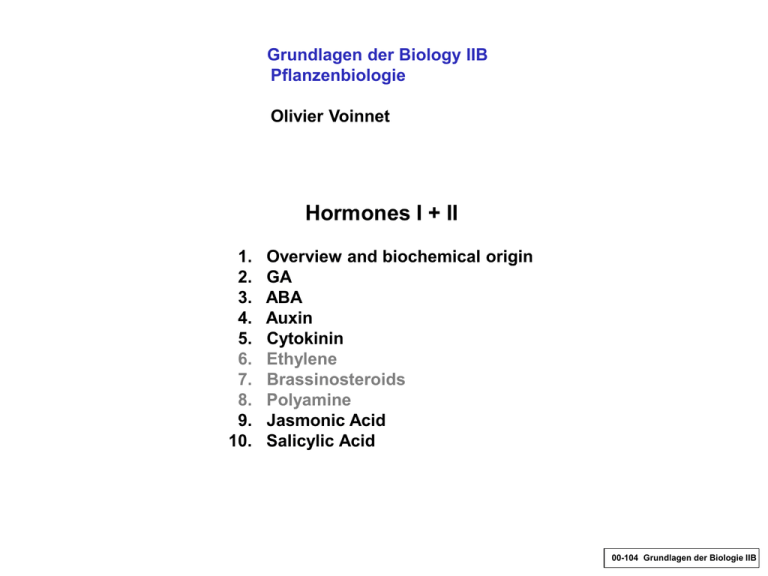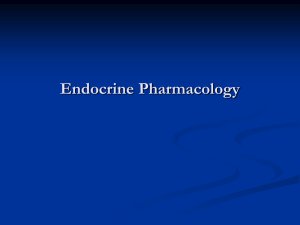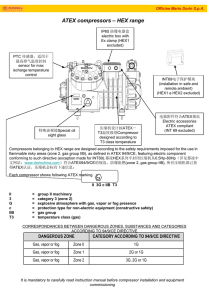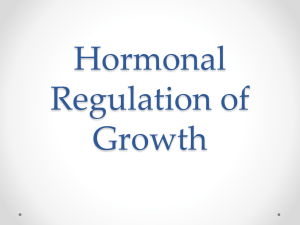
Grundlagen der Biology IIB
Pflanzenbiologie
Olivier Voinnet
Hormones I + II
1.
2.
3.
4.
5.
6.
7.
8.
9.
10.
Overview and biochemical origin
GA
ABA
Auxin
Cytokinin
Ethylene
Brassinosteroids
Polyamine
Jasmonic Acid
Salicylic Acid
00-104 Grundlagen der Biologie IIB
OVERVIEW AND BIOCHEMICAL ORIGINS
Definition
Hormone (from Greek ὁρμή) = « impetus »; « activating/pushing »
« A chemical released by a cell or a gland in one part of the body that sends out
messages that affect cells in other parts of the organism »
Only a small amount of hormone is required to alter cell metabolism
All multicellular organisms produce hormones
Plant hormones are also called phytohormones
Cells respond to a hormone when they express a specific receptor for that hormone
The hormone binds to the receptor protein, resulting in the activation of a signal
transduction mechanism that ultimately leads to cell type-specific responses
Hormones may act differently on different cell types
Inappropriate hormone doses may trigger opposing effects, making their study
relatively difficult
A hormone may also regulate the production and release of other hormones..
00-104 Grundlagen der Biologie IIB
OVERVIEW AND BIOCHEMICAL ORIGINS
In Animals (I)
1.
2.
3.
4.
Biosynthesis of a particular hormone in a particular tissue
Storage or secretion of the hormone
Transport of the hormone to target cell(s)
Recognition of the hormone by an associated cell membrane or intracellular
receptor protein
5. Relay and amplification of the received hormone via a signal transduction
process leading to a cellular response.
6. The reaction of the target cells may then be recognized by the original hormoneproducing cells, leading to a down-regulation in hormone production via homeostatic
negative-feedback loop
7. Degradation of the hormone.
>60 known hormones in humans, and there may be more (sexual arousal):
▪ stimulation or inhibition of growth
▪ mood swings
▪ induction or suppression of apoptosis (programmed cell death)
▪ activation or inhibition of the immune system
▪ regulation of metabolism
▪ preparation of the body for mating, fighting, fleeing, and other activity
▪ preparation of the body for a new phase of life, such as puberty, parenting,
menopause
▪ control of the reproductive cycle
▪ hunger cravings
00-104 Grundlagen der Biologie IIB
OVERVIEW AND BIOCHEMICAL ORIGINS
In Animals (II)
Some hormones function over long-distances in the blood stream
- from endocrine glands (thyroid, ovaries, testes)
- from neuro-secretory cells
Others function at close ranges
- signal transduction via synapses (neuro-secretory cells)
- paracrine signal transduction (diffusion from one cell to another)
Various types of hormones
- steroid hormones, mostly derived from cholesterol (e.g. testosterone)
- peptide hormones are chains of amino acids devided into:
- short peptide (THR, vasopressin);
- protein hormones (insulin, growth hormone);
- Monoamine hormones are derived from single aromatic amino acids
like phenylalanine, tyrosine, tryptophan (adrenaline);
- Gazeous hormones include Nitrogen monoxyde (vasodilatation, increased
blood flow)
Modes of action
- receptor binding
- signal transduction
Regulation
- enzyme activity
- gene expression
00-104 Grundlagen der Biologie IIB
OVERVIEW AND BIOCHEMICAL ORIGINS
In Plants (I)
Similar in their principle to animal hormones, but not so well understood
Not secreted in specialized organs (no ‘glands’)…
but sometimes more specific biosyntetic zones
Drastically different effects depending on concentration:
- low auxin levels -> main root elongation
- higher levels
-> elongation stopped, lateral root formation enhanced
Rarely act in isolation, and often in coordination with other hormones
- Auxin + Cytokinin -> cell division
Most phytohormones are transported by the phloem and then:
- are actively transported from cell to cell
- or diffuse passively through the cell wall
Possible gazeous emissions in the atmosphere (ethylene) or in the rizosphere
(strigolactone)
13 distinct plant hormones are known, but, as in animals, there may be many more!
00-104 Grundlagen der Biologie IIB
Phytohormones divided into 3 main classes
monoamine- hormones
Isoprenoid-derived hormones
tryptophane
methionin
phenylalanin
arginin
Lipid-derived hormones
Linoleate
00-104 Grundlagen der Biologie IIB
OVERVIEW AND BIOCHEMICAL ORIGINS
In Plants (II)
Peptide hormone:
- Systemin
wound signalling
Isoprenoide-derived hormones
- Giberellic acid (GA):
germination, internode elongation, flower and fruit development
- Abscisic acid (ABA): growth reduction, stomata aperture, bud dormancy, abscision
- Cytokinins:
cell division, germination and bud formation, prevents ageing
- Brassinosteroids (BR) cell expansion, cell elongation
- Strigolactone
inhibition of shoot branching, stimulates mycorrhizae
Monoamine hormones
- Auxin (IAA)
- Ethylene (C2H4)
- Salicylic acid (SA)
- Polyamine
cell elongation, root growth, differentiation, tropism
fruit ripening, ageing
pathogen defense, anesthtic Aspirin (F. Bayer, 1889)
stimulates DNA, RNA and protein synthesis, promotes growth
Lipid-derived hormones
- Jasmonic acid
pathogen defense, essential oil (jasmin)
Some with agonistic or synergisitc effects: BR & IAA: elongation
Some with antagonistic effects: ABA & GA: growth
00-104 Grundlagen der Biologie IIB
GIBERELLIC ACID (GA)
« Bakanae » disease in rice
1898 : Hori shows that symptoms are caused by
infection with a fungus in the genus fusarium;
1912: Sawada suggests elongation in rice seedlings
infected with bakanae fungus might be due to a
« stimulus » derived from fungal hyphae;
1930s:
perfect stage of the fungus is named
Gibberella fujikuroi and can be cultured in the lab;
1934: Yabuta isolate a crystalline compound from the
fungal culture filtrate that induces growth of rice
seedlings at all concentrations tested. Named « fusaric
acid » and later « giberillic acid » or GA;
1950s: Optimal fermentation procedures for the fungus
allow large-scale production of GA
In parallel, researchers realize that a compound with similar properties is naturally
produced by plants! It is isolated through the same procedures and found to:
Stimulate stem elongation by stimulating cell division and elongation ✓
Stimulates bolting/flowering in response to long days
Breaks seed dormancy in some plants which require stratification or light to induce
germination
Stimulates enzyme production (α-amylase) in germinating cereal grains for ✓
mobilization of seed reserves
Induces maleness in dioecious flowers (sex expression)
Can cause parthenocarpic (seedless) fruit development
Can delay senescence in leaves and citrus fruits
00-104 Grundlagen der Biologie IIB
Gibberellins promote
cell elongation
Tanginbozu Dwarf Rice
+GA
Cabbage (long
day plant)
Dwarf maize
Dwarf pea
00-104 Grundlagen der Biologie IIB
Cytoplasm: dioxygenases
GA biosynthesis takes place in 3
different sub-cellular compartments
Strictly regulated by:
Light
Temperature
Feedback
IP-PP
ER: P450 monooxygenases
ent-Keuren
GG-PP
Proplastisds: Cyclases
00-104 Grundlagen der Biologie IIB
Unlike auxin, GA is not transported in a polar way
Normal
orientation
The same amount of GA
moves from the upper
donor block to the lower
block no matter the
polarity of the stem
segment. By contrast,
auxin moves much more
efficiently from stem apex
to base.
Inverted
orientation
Adapted from Kato, J. (1958) Non polar transport of gibberllin through pea stem and a method for its determination. Science 128: 10081009.
00-104 Grundlagen der Biologie IIB
GAs are graft-transmissible; they can move long distances
WT - d1
In pea, a mutant
na shoot is
rescued by
grafting onto a
Na root.
na
Na
na
na
Maize seedlings are
grafted side-by-side
d1- d1
In maize, GA or a GAprecursor moves from the
wild-type plant to d1 and
promotes growth.
Proebsting, W.M., et al. (1992). Gibberellin concentration and transport in genetic lines of pea : Effects of grafting. Plant Physiol. 100: 13541360; Katsumi, M., et al. (1983). Evidence for the translocation of gibberellin A3 and gibberellin-like substances in grafts between normal,
dwarf1 and dwarf5 seedlings of Zea mays L. Plant Cell Physiol. 24: 379-388 Copyright 1983 Japanese Society of Plant Physiologists, with
permission.
00-104 Grundlagen der Biologie IIB
Analysis of Arabidopsis ga mutants reveals a potential signal transduction
pathway, which controls GA-dependent elongation growth
X
*
*
X
*
*spy: recessive mutation,
GA receptor is constitutively active
*spy
*gai
*gai: dominant mutation, DELLA protein
GA receptor not functional
*ga1: dominant mutation, DELLA protein
Repressor constitutive
*ga1
*rga: revertant of ga1: repressor is
altered
*rga
00-104 Grundlagen der Biologie IIB
Crystal structure of GID1, a nuclear GA receptor
GA
DELLA
repressor
Receptor
N terminus
GID1
Nuclear
receptor
Binding of gibberellin within its receptor…
causes the receptor's N-terminus to close over the hormone like a lid…
closing the lid provides a platform for binding gene transcription blockers or DELLA…
thereby making them available for destruction
00-104 Grundlagen der Biologie IIB
During seed germination, starch degrading enzymes are mobilized through a GA
dependent signal transduction pathway
00-104 Grundlagen der Biologie IIB
GA binds extracellular
receptor
G proteins activated :
transient elevation of
cyclic-GMP
Calcium signalling
activated to induce golgivesicle secretion
An unknown signal
transduction cascade is
activated
And reach the DELLA
factor Sln1 to induce Sln1
degradation
GAMYB is activated
Alpha-amylase is activated
and loaded into vesicles
But membranous GA
receptor remains unknow!!
00-104 Grundlagen der Biologie IIB
GA are extremely important food sustainability worldwide e.g. « Green revolution » rice
Development of high yielding varieties of cereal grains between the 60s and 70s
High yielding varieties have higher nitrogen absorbing potential
But cereals absorbing extra nitrogen typically fall over before harvest
so dwarf cultivars were created by breeding dwarfism genes including ga genes
reduced stem growth allows photosynthetic investment in the stem to be realocated to
grain production and filling, increasing yield dramatically
00-104 Grundlagen der Biologie IIB
ABSCISIC ACID (ABA)
1960s: a factor inducing bud dormancy in woody plants is identified
1960s: a factor inducing abscission of fruits and flowers is identified
it is the same factor !
Effects not due to an induction of dormancy, but rather, by increased tolerance to
water loss
Only in 1992 did plant physiologists agreed on the term “abscisic acid” !
Abscisic acid (ABA) has an
asymmetric C in the 1’ position acting
as a chiral center
possible S or R enantiomers
only S enantiomer exist in plants
Light converts Cis into Trans ABA
00-104 Grundlagen der Biologie IIB
ABA can be synthesized via a direct (FPP) or indirect (Xanthophyll) biochemical pathway
starts from beta cartene produced
in chloroplasts
chloroplast
hence,
leaves
biosynthesis
mostly
in
ABA is a breakdown product
violaxanthin (C40)
of
leading, among other products, to
xanthonin (C15), which is unstable
Direct synthesis also occurs from
FPP (C15)
ABA
Farnesyl
diphosphate
xanthonin
Beta-Carotene
vp = “vivipary” mutants in maize
violaxanthin
00-104 Grundlagen der Biologie IIB
Inhibits shoot growth but will not have as much affect on roots or may even promote
growth of roots
Inhibits the affect of gibberellins on stimulating de novo synthesis of alpha-amylase
Induces gene transcription especially for proteinase inhibitors in response to wounding
But ABA has two major roles
Stimulates the closure of stomata (water stress promotes an
increase in ABA synthesis).
Induces seeds to synthesize storage proteins and to avoid early
germination
Both are intimately linked to the retention of water in organs
Vivipary maize mutant
ABA-induced stomatal closure
00-104 Grundlagen der Biologie IIB
H2O-stress, Tutankhamen, Canna compacta and Verbascum blattaria
During water stress, ABA moves from root to shoot in the Xylem
In normal conditions (acidic pH) ABA is degraded and distributed to paranchyma cells
In water stress, neutral pH stabilizes ABA and distributes it to guard cells (shrinking)
3000 years old rye seeds!
600 years old
King Tutankhamen
Canna compacta
(Blumenrohr)
germinates after
burial in bottles
Verbascum blattaria
(Königskerze)
In all cases, enough water
stored to resume germination!
00-104 Grundlagen der Biologie IIB
The contribution of ABA to stomatal closure can be shown directly, but the signal
transduction pathway is not fully known yet
In the absence of ABA, the phosphatase PP2C is
free to inhibit autophosphorylation of SnRk
kinases
Closure of guard cells within minutes
ABA receptor (PYR/RCAR) ony cloned in
2010!
Other ABA receptors likely exist.
ABA enables PYR/RCAR proteins to bind and
sequester PP2C
This relieves inhibition of SnRk, which becomes
autoactivated
and
phosphorylates
ABF
transcription factors
00-104 Grundlagen der Biologie IIB
00-104 Grundlagen der Biologie IIB









